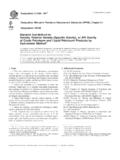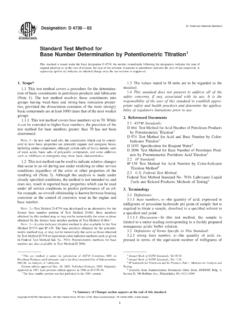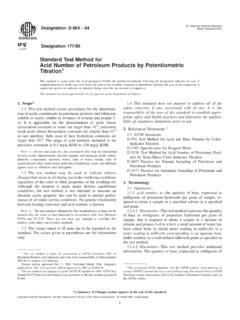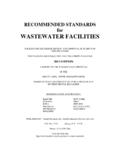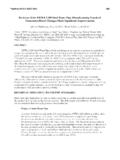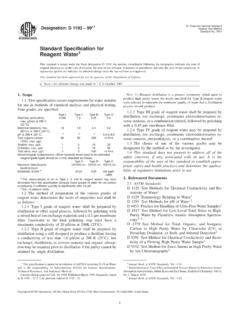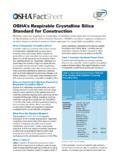Transcription of Standard Test Method for Water in Petroleum …
1 Designation: D 95 99e1 Designation: Manual of Petroleum Measurement standards (MPMS), Chapter : 74/82 (88)An American National StandardAmerican Association StateHighway Transportation StandardAASHTO No. T55 Standard Test Method forWater in Petroleum Products and Bituminous Materials byDistillation1 This Standard is issued under the fixed designation D 95; the number immediately following the designation indicates the year of originaladoption or, in the case of revision, the year of last revision. A number in parentheses indicates the year of last reapproval. A superscriptepsilon (e) indicates an editorial change since the last revision or Standard has been approved for use by agencies of the Department of Footnote 1 and the Referenced Documents were corrected editorially to comply with the ASTM-API joint standardcontract in October 2002. Warning notes were editorially moved into the Standard text in October This test Method covers the determination of Water inthe range from 0 to 25 % volume in Petroleum products, tars,and other bituminous materials by the distillation Volatile Water -soluble material, if present, may be measuredas The specific products considered during the develop-ment of this test Method are listed in Table 1.
2 For bituminousemulsions refer to Test Method D 244. For crude oils, refer toTest Method D 4006 (APIMPMSC hapter ).NOTE2 With some types of oil, satisfactory results may be obtainedfrom Test Method D 1796 (APIMPMSC hapter ). The values stated in SI units are to be regarded as thestandard. The values in parentheses are for information Standard does not purport to address all of thesafety concerns, if any, associated with its use. It is theresponsibility of the user of this Standard to establish appro-priate safety and health practices and determine the applica-bility of regulatory limitations prior to specific hazardstatements, see Section Referenced standards :D 244 Test methods for Emulsified Asphalts2D 1796 Test Method for Water and Sediment in Fuel Oils bythe Centrifuge Method (Laboratory Procedure) (APIMPMSC hapter )3D 4006 Test Method for Water in Crude Oil by Distillation(APIMPMSC hapter )4D 4057 Practice for Manual Sampling of Petroleum andPetroleum Products (APIMPMSC hapter )4D 4177 Practice for Automatic Sampling of Petroleum andPetroleum Products (APIMPMSC hapter )4D 5854 Practice for Mixing and Handling of LiquidSamples of Petroleum and Petroleum Products (APIMPMSC hapter )5E 123 Specification for Apparatus for Determination ofWater by standards .
3 7 MPMSC hapter Manual Sampling of Petroleum andPetroleum Products (ASTM Practice D 4057)MPMSC hapter Automatic Sampling of Petroleum andPetroleum Products (ASTM Practice D 4177)MPMSC hapter Mixing and Handling of Liquid Samplesof Petroleum and Petroleum Products (ASTM PracticeD 5854)MPMSC hapter Determination of Water in Crude Oilby the Distillation Method (ASTM Test Method D 4006)MPMSC hapter Test Method for Water and Sediment in1 This test Method is under the jurisdiction of ASTM Committee D02 onPetroleum Products and Lubricants and the API Committee on Petroleum Measure-ment, and is the direct responsibility of Subcommittee , the jointASTM-API Committee on Static Petroleum edition approved June 10, 1999. Published August 1999. Originallypublished as D 95 21. Last previous edition D 95 83 (1990).2 Annual Book of ASTM standards ,Vol Book of ASTM standards , Vol Book of ASTM standards ,Vol Book of ASTM standards ,Vol Book of ASTM standards , Vol as Manual of Petroleum Measurement standards .
4 Available from theAmerican Petroleum Institute (API), 1220 L St., NW, Washington, DC ASTM International, 100 Barr Harbor Drive, PO Box C700, West Conshohocken, PA 19428-2959, United Oils by the Centrifuge Method (Laboratory Proce-dure) (ASTM Test Method D 1796)3. Summary of Test The material to be tested is heated under reflux with awater-immiscible solvent, which co-distills with the Water inthe sample. Condensed solvent and Water are continuouslyseparated in a trap, the Water settling in the graduated sectionof the trap and the solvent returning to the Significance and A knowledge of the Water content of Petroleum productsis important in the refining, purchase, sale, and transfer The amount of Water as determined by this test Method (to the nearest volume %) may be used to correct thevolume involved in the custody transfer of Petroleum productsand bituminous The allowable amount of Water may be specified Solvent-Carrier A solvent-carrier liquid appropriate to the material beingtested (see Table 1) shall be Solvent The following aromatic solventsare Grade Xylene (Warning harmful.)
5 A blend of 20 volume % industrial grade toluene and80 volume % industrial grade xylene. (Warning harmful.) or Coal Tar Naphtha, free of Water ,yielding not more than 5% distillates at 125 C (257 F) and notless than 20% at 160 C (320 F) and with a relative density(specific gravity) not lower than at C(60/60 F). (Warning Extremely flammable. Harmful if in-haled. Vapors may cause fire.) Distillate Solvent A Petroleum distillatesolvent, 5% boiling between 90 and 100 C (194 and 212 F)and 90% distilling below 210 C (410 F), shall be used. Percentmay be determined by mass or by volume. These solvents areavailable from most chemical companies under the name ofstoddard solvent or ligroine. (Warning Flammable. Vaporharmful.) Spirits Solvent The following volatile spiritssolvents are Spirit, with a boiling range from 100 to120 C (212 to 248 F). (Warning Flammable. Vapor harm-ful.) , of 95% purity or better.
6 (Warning Extremely flammable. Harmful if inhaled. Vapors may causefire.) Blank The Water content of the solvent shallbe determined by distilling an equivalent amount of the samesolvent used for the test sample in the distillation apparatus andtesting as outlined in Section 9. The blank shall be determinedto the nearest scale division and used to correct the volume ofwater in the trap in Section The apparatus comprises a glass or metalstill, a heater, a reflux condenser, and a graduated glass still, trap, and condenser may be connected by any suitablemethod that produces a leakproof joint. Preferred connectionsare ground joints for glass and O-rings for metal to assemblies are illustrated in Fig. 1, Fig. 2, and Fig. stills and traps should be chosen to cover the range ofmaterials and Water contents expected. On assembly, careshould be taken to prevent the joints from freezing or may be prevented by the application of a very thin film ofstopcock A glass or metal vessel with a short neck andsuitable joint for accommodating the reflux tube of the trapshall be used.
7 Vessels of 500, 1000, and 2000-mL nominalcapacity have proved A suitable gas burner or electric heater may beused with the glass still. A gas ring burner with ports on theinside circumference shall be used with the metal still. The gasring burner shall be of such dimensions that it may be movedup and down the vessel when testing materials that are likely tofoam or solidify in the Dimensions and descriptions of typicalglassware for use in this test Method are provided in Specifi-cation E Instead of standardizing on a particular apparatus specifica-tion with respect to dimensions and style, a given apparatus will bedeemed satisfactory when accurate results are obtained by the standardTABLE 1 Type of Solvent-Carrier Liquid Versus Material to BeTestedType of Solvent-Carrier LiquidMaterial to be TestedAromaticasphalt, tar, coal tar, Water gas tar, roadtar, cut-back bitumin, liquid asphalt, taracidPetroleum distillateroad oil, fuel oil, lubricating oil, petroleumsulfonatesVolatile spiritslubricating greaseFIG.
8 1 Typical Assembly with Glass StillD95 99e12addition technique described in Section Sampling is defined as all steps required to obtain analiquot of the contents of any pipe, tank, or other system and toplace the sample into the laboratory test container. Onlyrepresentative samples obtained as specified in PracticesD 4057 (APIMPMSC hapter ) and D 4177 (APIMPMSC hapter ) shall be used for this test The size of the test portion should be based on theexpected Water content of the sample, such that the Water yielddoes not exceed the capacity of the trap (unless a trap with astopcock is used permitting excess Water to be withdrawn intoa graduated cylinder). Practice D 5854 (APIMPMSC hapter ) containsinformation on sampling and homogenization efficiency ofunknown mixers. This test Method should not be followedwithout strict adherence to Practice D 5854 (APIMPMSC hapter ).8. The accuracy of the graduation marks on the trap shallbe certified or verified, using only national or internationalstandards, such as National Institute of standards and Technol-ogy (NIST)8traceable equipment.
9 Verification shall be with atraceable 5 mL Micro Burette or Micro Pipette, readable to thenearest In styles A, B, C, and D, as specified in Table 2(Table 1 in Specification E 123), each subdivision (that is, through mL) in the conical portion of the tube shall beverified. Thereafter, each major subdivision (that is, mL, mL, mL, and up to the total volume of the trap) shall In styles E and F, as specified in Table 2, each majorsubdivision ( mL, mL, mL, mL, and mL inthe case of Style E; mL, mL, mL, mL, and in the case of Style F) shall be The entire glassware assembly shall be calibrated priorto use as Put 400 mL of dry ( % Water maximum) xylene orthe solvent to be utilized in the analysis of unknown samplesinto the apparatus and test in accordance with Section 9. Whencomplete, discard the contents of the trap and add the volumeof Water as specified as first test in Table 3 directly to thedistillation flask and test in accordance with Section Repeat the test in , and add the volume specifiedas second test in Table 3 directly to the flask.
10 The assembly ofthe apparatus is satisfactory only if the trap readings are withinthe tolerances specified in Table A reading outside the permissible limits suggests amalfunction resulting from vapor leaks, too rapid boiling,inaccuracies in calibration of the trap, or ingress of extraneousmoisture. Eliminate these factors before repeating the ProcedureNOTE4 Caution:The precision of this test Method will be affected bywater droplets adhering to surfaces in the apparatus and therefore notsettling into the Water trap to be measured. To minimize the problem, allapparatus must be cleaned chemically at least daily to remove surfacefilms and debris, which hinder free drainage of Water in the test frequent cleaning is recommended if the nature of samples being runcauses persistent Measure a suitable amount of sample to an accuracy of61% and transfer it to the Measure ordinary liquid samples in a graduated cylinderof an appropriate size.
